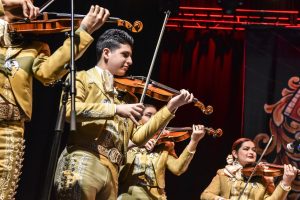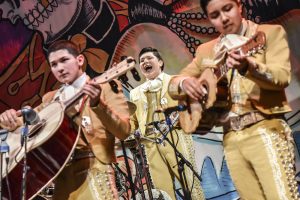
Photo courtesy of Mariachi Herencia México. Used with permission.
As music genres go, there is none as celebratory and festive as mariachi music. It’s a folk tradition that began around the 18th century, with roots in cities like Guadalajara and Mexico City. My love for mariachi music deepened during a trip to Mexico City in 2002 when I visited Plaza Garibaldi, a site where mariachi bands play day and night. Fortunately for Hoosiers, it can be heard locally in some Mexican restaurants, and gatherings such as weddings and quinceañeras. To hear mariachi music presented on such a grand scale as I witnessed on Monday at Clowes Memorial Hall at Butler Arts Center was a totally different experience, and frankly, one that was flabbergasting. The source of my amazement was a concert presented by Mariachi Herencia México. Herencia translates to “legacy” and refers to mariachi music in the sense of heritage.
Comprising 14 young, Mexican American musicians, 12 men and two women, the Chicago-based group has released four acclaimed studio albums that made their chart-topping debuts on Billboard and the iTunes Latin albums charts. In 2017, Mariachi Herencia México was recognized with a Latin Grammy nomination in the “Best Ranchera/Mariachi Album” for its debut album “Nuestra Herencia.”The group recently released its fourth album titled “Esencia (Essence) Vol. 2.” They’ve earned praise from mariachi expert and historian Jonathan Clark, who said, “It’s a masterpiece. This is mariachi music at its most sophisticated and modernistic. It’s almost the antithesis of folklore, almost futuristic. Maybe 20 or 30 years from now, all groups will sound like this. I don’t know, but state of the art it is.” Mariachi Herencia de Mexico has toured throughout the U.S., Mexico and Canada, performing in prestigious performing-arts venues across North America, including Kennedy Center in Washington, D.C. and Guadalajara’s Teatro Degollado.

Photo courtesy of Mariachi Herencia México. Used with permission.
As far as Clark calling the group “state of the art,” based on what I saw at Monday’s concert, there was no question his assertion is right on point. Not only did the musicians play instruments that included violins, trumpets, a high-pitched guitar called a vihuela, an acoustic bass guitar called a guitarrón, but many of them also took turns singing leads and backup vocals that were pitch perfect. Displaying virtuoso musicianship, they were also master showmen in a concert that was as carefully choreographed and slickly produced as I have ever seen on any stage. Adding to the spectacle of it all were video images with Mexican motifs that were projected behind the group, dazzling lighting design, and sound design that was impeccable.
Playing to a wildly enthusiastic, modestly sized audience made up primarily of those of Mexican origins, the mariachi group, dressed in elaborate charro costumes, captivated the crowd during its fast-paced 90-minute show, without intermission. With various musicians making bilingual introductions of songs, the program consisted of mostly classic mariachi songs and even a few songs in English. They included tunes such as “Gallo de Oro,” “Bésame Mucho,” “Así Son Los Hombres,” a medley of songs from the film “Coco,” Arrieros Somos,” a medley of songs honoring the Mexican Revolution, country classics “Crazy” and “Orange Blossom Special,” “Curcurrucú Paloma,” “Charr ada,” “Así Fue,” and “Como México.” For the encore, which brought the audience to a frenzy and its feet, the group performed “El Son de la Negra,” a folk song considered a masterpiece and commonly referred to as the “second national anthem of Mexico.”
As a sixth generation Mexican American, hearing this genre of music presented with such passion and artistry, filled me with me with emotion and pride in my roots that is difficult to express in words. Suffice to say, I am also grateful Butler Arts Center presented the group in the first place. Exposing local audiences to Mexican music, they join other venues such as the Palladium that recently hosted “Las Cafeteras” and The Cabaret that introduced “Flor de Toloache” to Indy audiences. Considering the local Mexican immigrant community continues to grow, if not burgeon, in Central Indiana, it’s a credit to these organizations that they are not only targeting this demographic, but also realize the importance of exposing the wider community to a culture that has become an integral part of our diverse social fabric.





